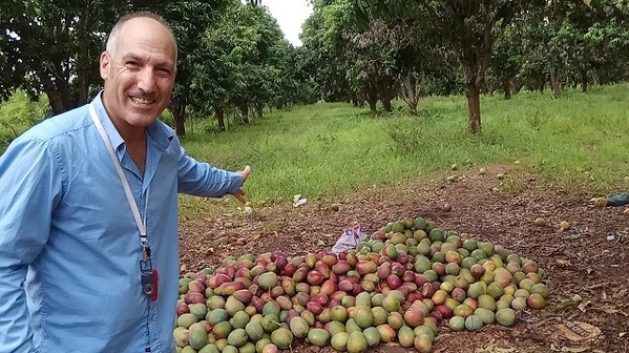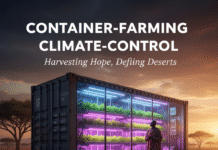Fruits waiting to be collected to the market (Biofeed…)
The Status of Fresh Produce Export
Although favorable environmental conditions, limitless availability of land, and high demands of fruits and vegetables at the target markets, the export of fresh agricultural produce from most African (and Asian) countries is very small and nearly insignificant.
| The Benefits of Fresh Produce Export Export of fresh fruits and vegetables can change the local economy, by various ways, such as creating a steady flow of foreign currency into the country, create many more well-paid jobs, and increase the income of farmers and the entire value chain involved the food growing, food production and food export. I grew up and raised in Israel, where export of fresh agricultural produce is an integral part of the agriculture management system and any farmer who wants to export can do it easily. By working with the entire value chain of fruit export, I gained the understanding of export benefits and I am familiar with the methods of doing it.  I consider Export as the #1 indicator for a successful economy, as well as successful agriculture. It is considered prestigious to export food products, and a country, which is doing so, is considered as advanced and valuable to the world economy. Biofeed developed the FreeDome pest control solution, to be extremely effective and eco-friendly so farmers can grow better, easier, and increase their income by way of… export! In my opinion, any farmer who cannot export or sell his produce at the international export market prices is practically ”leaving money on the table”, and so is his country. Why Many Farmers / Countries Do Not Export (or export a little)? If benefits from fresh products export are so significant to the farmer and to the value chain, then why most of the farmers in Africa (and elsewhere) do not export fresh products? Are they willingly giving up on export or are there other reasons that ‘contribute’ to that situation? From my own experience, most of the farmers I met in Africa, Asia and elsewhere show high interest to increase their export and resulting income. It is clear to me that they do want a better life, higher income and they do understand that export will help them achieve this and more. Well, if farmers do want to export then what is stopping them, what other reasons can explain the low volume of fresh produce exported from Africa and Asia? The Other Reason To understand the Other Reasons we first need to understand what it takes to export. Exporting agricultural products, especially fresh ones, requires a well-organized and sophisticated organization with proper infrastructure setup, readiness for financial investment, compliance with the most stringent export criteria and standards throughout the value chain, and intimate acquaintance and access to the high value, fresh food designated international markets. It should be noted that different export markets have different requirements, and generally, exporters would have to meet more stringent requirements as they target a market with higher return on investment (ROI) value. For example, exporting to a neighboring country in Africa involves meeting lower barriers and standards compared to exporting to a non-African country. However, we also expect the potential export volume and price to be lower as well. At the same time, if the same exporter wants to export high volumes to high value demanding markets, such as Europe or Japan (where prices are much higher), he will be required to meet much higher standards and barriers. The First Step In A Thousand-Mile Journey To Export  What do farmers and countries are facing when they wish to export fresh produce? The Basic Requirements farmers and countries need to meet: 1. Quality – in accordance with the required standards in the target market. The most common requirements are for zero chemical residues and zero quarantine pests’ (e.g. fruit flies) infestation. 2. Documentation and proof of standards compliance. The most common basic requirement is the GAP (Good Agricultural Practice) standard. 3. Quantity – farmer’s yield per hectare, and sufficient export volume per country. High yield per hectare is a must to finance the high costs involved in financing the farmer’s road to export. For example, a mango orchard bearing 4 tons per hectare is very common around Africa and Asia, while in Israel it is 40 tons per hectare.  Considering the high costs involved in compliance with the Quality and Documentation criteria, you will surely understand that even if a farmer has the most quality and beautiful produce, e.g. mango, citrus, persimmon, and pineapple, he cannot export it if he has only a single fruit or As important, is the involvement at the country-level, which needs to provide the costly infrastructure and support for export activity (like bureaucracy barriers as an example). In order for the country to break even and have a successful economic and sustainable export endeavor, the export volume must reach a certain minimum (often tens of thousands of tons per year, and above). The Gap Today, most African and Asian farmers do not meet one or more of the above basic criteria and requirements, and their countries lack much of the necessary infrastructure and expertise to support them in their strive to reach export markets. But, there is more to it, because a farmer does not simply export his produce. In fact, the fresh produce export value chain is long, complex, often difficult to understand and to apply, and is very costly. After harvest, the farmer sends the produce to the packaging house. The packinghouse also has to meet strict standards. However, not many packinghouses do comply. Then there is the issue of cooling storage infrastructure and the cooling transport chain, which is often missing or faultily considered as not critical. There is the issue of logistics, meaning taking the produce from the field to the packinghouse to the cooling infrastructure to the storage before export, to the port, to the export markets, etc. Logistics is a considerable hurdle in keeping the produce quality, as in many countries the poor roads infrastructure damage the fruits (i.e. when the truck ‘jumps’ the fruit gets hit) and the long time it takes from the field to the packaging and later to the port. Note, careless handling of agricultural produce at the post-harvest stages may reduce the export rate by 50%. Compliance with stringent requirements can become a problem as well, when (often) there is no laboratory to check that the product meets the standard. Enforcement of the standard is often ineffective (due to non-existing tools like laboratory or non-professional inspector level or other harming ways to allow the unfit, low quality, product to pass). Such behavior is destructive to those who do stand up to the requirements, but it mainly damaging the country position as a food exporter. In addition, there is the issue of the concept of Time in Africa, which is very ‘flexible’ but must be very rigid when it comes to the export of food products. All the above is the basis for Marketing, Branding, and the uncompromising notion of Quality, which is the entering gate to Premium Price for Premium Produce. The Outcome of The Above Gap In Africa and Asia only a few farmers, exporters and nations do meet export requirements, while many more do not. The bottom line result? NO EXPORT. The Other Reasons Do Matter We understand that it is not the farmers who prevent fresh products export. Instead, it is the complexity and the multi-stage process that is necessary in order to achieve the goal of export. Furthermore, we cannot separate the stages and gradually apply them. That will not work! To succeed and to export we must set and apply the entire value chain – SIMULTANEOUSLY! It is enough that one link in the chain is weak, and the whole chain will collapse.  A Way Forward The Green Valley National Export Project realizes all of the above issues. Therefore, the project approach is holistic, one that looks at the entire value chain takes care of each link, and apply it all simultaneously as a complete and total solution. To be able to deliver it we see enormous importance of having a qualified strong managerial team to manage the project properly – in a business-oriented manner and in close cooperation with the country government. The basic of the project is, therefore: Understanding that this is a long-lasting, continuous NATIONAL PROJECT, which may require the involvement of several Governmental institutions (Ministries). Applying short and intensive timeline of up to 5 years to achieve simultaneous appliance to the Basic Requirements of – * Export Quality, standing to the highest standards. * Documentation and enforcement of requirements. * Increasing the yield at the farmer level to the level of leading farmers around the world, and at the national level setting up annual export to tens of thousands of tons (within 5 years!). Green Valley National Export Projects is complex in terms of its initial setup and operation, but while moving forward the program Road-Map offers a clear (even if uneasy), convenient and understandable route for the farmer and the state to rich to the target of significant, high-value, exporters. We, at the Green Valley National Export Projects, believe that we should not fear from past failures, but rather learn from the past in order to design a better business model that will lead to a better future.
|








